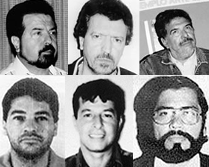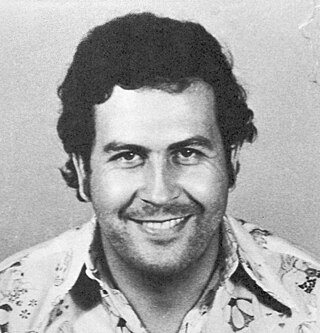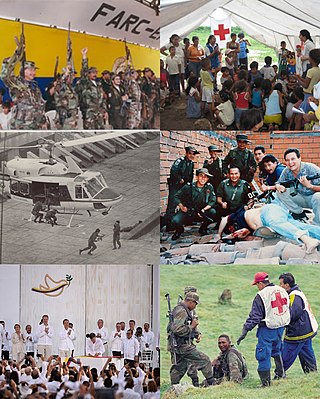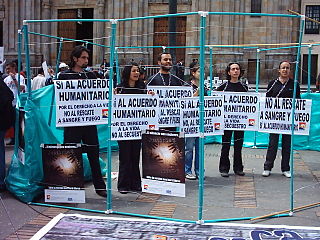Related Research Articles

The history of Colombia includes its settlement by indigenous peoples and the establishment of agrarian societies, notably the Muisca Confederation, Quimbaya Civilization, and Tairona Chiefdoms. The Spanish arrived in 1499 and initiated a period of annexation and colonization, ultimately creating the Viceroyalty of New Granada, with its capital at Bogotá. Independence from Spain was won in 1819, but by 1830 the resulting "Gran Colombia" Federation was dissolved. What is now Colombia and Panama emerged as the Republic of New Granada. The new nation experimented with federalism as the Granadine Confederation (1858) and then the United States of Colombia (1863) before the Republic of Colombia was finally declared in 1886. A period of constant political violence ensued, and Panama seceded in 1903. Since the 1960s, the country has suffered from an asymmetric low-intensity armed conflict which escalated in the 1990s but decreased from 2005 onward. The legacy of Colombia's history has resulted in a rich cultural heritage, and Colombia's geographic and climatic variations have contributed to the development of strong regional identities.

The Revolutionary Armed Forces of Colombia – People's Army is a Marxist–Leninist guerrilla group involved in the continuing Colombian conflict starting in 1964. The FARC-EP was officially founded in 1966 from peasant self-defense groups formed from 1948 during La Violencia as a peasant force promoting a political line of agrarianism and anti-imperialism. They are known to employ a variety of military tactics, in addition to more unconventional methods, including terrorism.
Narcoterrorism, in its original context, is understood to refer to the attempts of narcotics traffickers to influence the policies of a government or a society through violence and intimidation, and to hinder the enforcement of anti-drug laws by the systematic threat or use of such violence. As with most definitions of terrorism, it typically only refers to non-state actors.

The Cali Cartel was a drug cartel based in southern Colombia, around the city of Cali and the Valle del Cauca. Its founders were the brothers Gilberto Rodríguez Orejuela, Miguel Rodríguez Orejuela and José Santacruz Londoño. They broke away from Pablo Escobar and his Medellín associates in 1988, when Hélmer "Pacho" Herrera joined what became a four-man executive board that ran the cartel.

The Medellín Cartel was a powerful and highly organized Colombian drug cartel and terrorist organization originating in the city of Medellín, Colombia, that was founded and led by Pablo Escobar. It is often considered to be the first major "drug cartel" and was referred to as such due to the organization's upper echelons and overall power-structure being built on a partnership between multiple Colombian traffickers operating alongside Escobar. Other members included Jorge Luis Ochoa Vásquez, Fabio Ochoa Vásquez, Juan David Ochoa Vásquez, José Gonzalo Rodríguez Gacha, and Carlos Lehder. Escobar's main partner in the organization was his cousin Gustavo Gaviria, who handled much of the cartel's shipping arrangements and the more general and detailed logistical aspects of the cocaine trafficking routes and international smuggling networks, which were supplying at least 80% of the world's cocaine during its peak.

The 19th of April Movement, or M-19, was a Colombian urban guerrilla movement active in the late 1970s and 1980s. After its demobilization in 1990 it became a political party, the M-19 Democratic Alliance, or AD/M-19.

The Colombian conflict began on May 27, 1964, and is a low-intensity asymmetric war between the government of Colombia, far-right paramilitary groups and crime syndicates, and far-left guerrilla groups, fighting each other to increase their influence in Colombian territory. Some of the most important international contributors to the Colombian conflict include multinational corporations, the United States, Cuba, and the drug trafficking industry.
The Revolutionary Armed Forces of Colombia (FARC–EP) is a Marxist–Leninist revolutionary guerrilla organization based in Colombia, which is involved in the ongoing Colombian armed conflict.
Right-wing paramilitary groups in Colombia are paramilitary groups acting in opposition to revolutionary Marxist–Leninist guerrilla forces and their allies among the civilian population. These right-wing paramilitary groups control a large majority of the illegal drug trade of cocaine and other substances. The Colombian National Centre for Historical Memory has estimated that between 1981 and 2012 paramilitary groups have caused 38.4% of the civilian deaths, while the Guerillas are responsible for 16.8%, 10.1% by the Colombian Security Forces and 27.7% by non-identified armed groups.

The relationship between Colombia and the United States evolved from a mutual cordiality during the 19th and early 20th centuries to an early-2000s partnership that linked the governments of both nations around several key issues; this includes fighting communism, the War on Drugs, and the threat of terrorism due to the September 11 attacks in 2001.
Fidel Antonio Castaño Gila.k.a.Rambo was a Colombian drug lord and paramilitary who was among the founders of Los Pepes and the Peasant Self-Defense Forces of Cordoba and Uraba (ACCU), a paramilitary group which ultimately became a member of the larger United Self-Defense Forces of Colombia (AUC) from which he became its leader until his death in 1994. He was also the brother of Vicente Castaño, the presumed chief of the narco-paramilitary group Águilas Negras, and Carlos Castaño Gil, founder and leader of the AUC paramilitary forces until his death. He is the grandfather of Gabriella Castaño. There is a theory that Fidel Castaño is still alive as there is no proof of him being dead and was the one that also killed Victor “Chepe” Crespo.
The FARC-Government peace process (1999–2002), from January 7, 1999, to February 20, 2002, was a failed peace process between the Government of President Andrés Pastrana Arango and the Revolutionary Armed Forces of Colombia (FARC) guerrilla group in an effort to bring to an end the ongoing Colombian armed conflict.

José Gonzalo Rodríguez Gacha, also known by the nicknames Don Sombrero and El Mexicano, was a Colombian drug lord who was one of the leaders of the Medellín Cartel along with the Ochoa brothers and Pablo Escobar. At the height of his criminal career, Rodríguez was acknowledged as one of the world's most successful drug dealers. In 1988, Forbes magazine included him in their annual list of the world's billionaires.

Jorge Luis Ochoa Vásquez is a Colombian former drug trafficker who was one of the founding members of the Medellín Cartel in the late 1970s. The cartel's key members were Pablo Escobar, Carlos Lehder, José Gonzalo Rodríguez Gacha, Gustavo Gaviria, Jorge Ochoa, and his brothers Juan David and Fabio.

Kidnappings in Colombia refers to the practice of kidnapping in the Republic of Colombia. This criminal practice was first introduced in modern Colombian history during the early 1970s by the guerrilla movements and, later, also by criminal groups. With the release of Colombian presidential candidate Ingrid Betancourt on July 2, 2008 this practice gained worldwide notoriety.

The illegal drug trade in Colombia has, since the 1970s, centered successively on four major drug trafficking cartels: Medellín, Cali, Norte del Valle, and North Coast, as well as several bandas criminales, or BACRIMs. The trade eventually created a new social class and influenced several aspects of Colombian culture, economics, and politics.
Colombia has a high crime rate due to being a center for the cultivation and trafficking of cocaine. The Colombian conflict began in the mid-1960s and is a low-intensity conflict between Colombian governments, paramilitary groups, crime syndicates, and left-wing guerrillas such as the Revolutionary Armed Forces of Colombia (FARC), and the National Liberation Army (ELN), fighting each other to increase their influence in Colombian territory. Two of the most important international actors that have contributed to the Colombian conflict are multinational companies and the United States.

The Clan del Golfo, also known as Gaitanist Self-Defense Forces of Colombia and formerly called Los Urabeños and Clan Úsuga, is a prominent Colombian neo-paramilitary group and currently the country's largest drug cartel.

Drug barons of Colombia refer to some of the most notable drug lords which operate in illegal drug trafficking in Colombia. Several of them, notably Pablo Escobar, were long considered among the world's most dangerous and most wanted men by U.S. intelligence. "Ruthless and immensely powerful", several political leaders, such as President Virgilio Barco Vargas, became convinced that the drug lords were becoming so powerful that they could oust the formal government and run the country.

Organised crime in Colombia refers to the activities of various groups of drug cartels, guerilla groups, organised crime syndicates or underworld activities including drug trafficking, contract killing, racketeering and other crimes in Colombia. Colombia has seen the rise and fall of drug empires, crime syndicates and organised guerrilla groups, all of which having contributed to the varying forms of organised crimes having occurred in Colombia.
References
- 1 2 Marc Chernick (March–April 1998). "The paramilitarization of the war in Colombia". NACLA Report on the Americas. 31 (5): 28. doi:10.1080/10714839.1998.11722772.
- ↑ James J. Brittain (2010). Revolutionary Social Change in Colombia: The Origin and Direction of the FARC-EP. Pluto Press. pp. 129–131. ISBN 978-0-7453-2876-8.
- ↑ Forrest Hylton (2006). Evil Hour in Colombia . Verso. pp. 68–69. ISBN 978-1-84467-551-7.
- 1 2 3 4 Human Rights Watch , "II. History of the Military-Paramilitary Partnership", Colombia's Killer Networks The Military - Paramilitary Partnership and the United States, 1996 (accessed: August 23, 2010)
- ↑ Nazih Richani (2002). Systems of Violence: the political economy of war and peace in Colombia. SUNY Press. p. 38.
- 1 2 Jasmin Hristov (2009). Blood and capital: the paramilitarization of Colombia. Ohio University Press. pp. 65–68. ISBN 978-0-89680-267-4.
- ↑ Santina, Peter "Army of terror", Harvard International Review, Winter 1998/1999, Vol. 21, Issue 1
- 1 2 3 4 Geoff Simons (2004). Colombia: A Brutal History. Saqi Books. p. 56. ISBN 978-0-86356-758-2.
- 1 2 Pearce, Jenny (May 1, 1990). 1st. ed. Colombia:Inside the Labyrinth. London: Latin America Bureau. p. 247. ISBN 0-906156-44-0
- ↑ Democracy Now!, Who Is Israel's Yair Klein and What Was He Doing in Colombia and Sierra Leone? Archived 2007-03-14 at the Wayback Machine , June 1, 2000.
- ↑ Harvey F. Kline (1999). State Building and Conflict Resolution in Colombia: 1986-1994. University of Alabama Press. pp. 73–74.
- ↑ Kleinfeld, Rachel; Barham, Elena (2018). "Complicit States and the Governing Strategy of Privilege Violence: When Weakness is Not the Problem". Annual Review of Political Science. 21: 215–238. doi: 10.1146/annurev-polisci-041916-015628 .